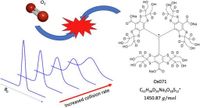Researchers have made significant strides in monitoring dissolved oxygen levels in fluid solutions using an innovative electron paramagnetic resonance (EPR) technique housed within a microchip. This groundbreaking advancement, detailed in a recent study published in Scientific Reports, introduces the EPR-on-a-chip (EPRoC) device, integrating the entire EPR spectroscopy system onto a single chip, making it easier and more efficient to analyze chemical processes.
The EPRoC device uses a voltage-controlled oscillator (VCO) to serve as both the microwave source and detector, allowing researchers to place the device directly into sample solutions without the traditional constraints of resonator-based EPR spectrometers. “This integration is a game-changer, as it allows for direct monitoring of dynamic processes in real-time,” said the authors of the article.
In their study, the team employed frequency-swept frequency-modulated rapid scan EPR (RS-EPR) to enhance the sensitivity of the EPRoC device, enabling it to measure triarylmethyl (trityl, Ox071) oxygen-sensitive probes dissolved in aqueous solutions. They tested this innovative method by varying the oxygen concentrations in the solutions from air-saturated to nitrogen-purged conditions, showing how the linewidth of EPR spectra changed in response to these variations.
The experiments demonstrated that the oxygenated linewidth was recorded at 160 mG, while the deoxygenated linewidth dropped to 50 mG. By precisely calibrating these measurements, they established a reliable relationship correlating the linewidths to the concentration of dissolved oxygen. Thus, the study found that the EPRoC device could detect changes in partial pressure of oxygen at a rate of 0.53 mmHg O2 per kHz, which is equivalent to 1.47 mmHg O2 per mG.
Such capabilities make the EPRoC device invaluable in various applications, particularly in medical diagnostics, where assessing oxygen levels in biological environments plays a crucial role in evaluating conditions like wound healing, blood oxygenation, and cardiovascular health. This need for accurate oxygen measurement is paramount for screening cardiovascular diseases and monitoring metabolic processes influenced by oxygen.
The researchers outlined the processes involved in measuring the oxygen concentration. They submerged the EPRoC device in a PBS buffer solution containing the Ox071 spin probe. After approximately six hours of purging with dry nitrogen gas, they began recording rapid scan spectra at thirty-second intervals to capture the reoxygenation of the solution.
The impressive aspect of this device is not only its sensitivity but also its ability to operate in environments where conventional EPR methods struggle due to solvent microwave absorption. The unique design of the EPRoC enables it to function effectively submerged in liquid, facilitating exciting new pathways for EPR applications in fluid environments.
As the authors highlight, while past EPR methods faced challenges with limitations on excitation bandwidth, the introduction of frequency-swept rapid scan EPR techniques within the EPRoC bypasses these constraints. This advancement significantly heightens the potential for in situ, real-time assessments of oxygen levels, which can profoundly impact clinical diagnostics and therapeutic monitoring.
Moving forward, researchers suggest that the EPRoC technology has vast implications beyond medical diagnostics. The versatility of the EPRoC opens new avenues for exploring chemical reactions in various fields, including materials science and environmental monitoring. By enabling continuous real-time measurements, the EPRoC could be harnessed in numerous contexts to provide insights previously unattainable.
With the team’s development of this chip-based EPR technology, the landscape of electron paramagnetic resonance spectroscopy stands to advance significantly, leading to heightened screening capabilities, improved health assessments, and a deeper understanding of biological processes influenced by oxygen. As they concluded, the EPRoC represents a promising step toward versatile point-of-care diagnostics, paving the way for further research and innovation in the realm of EPR technology.




